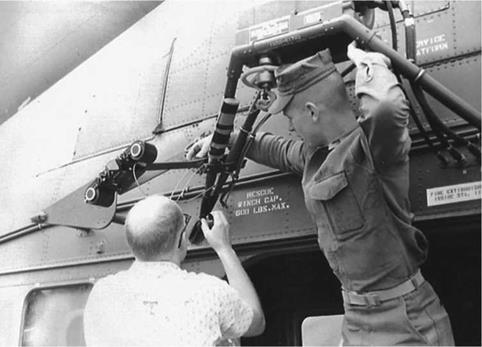THE MAN WITH THE CAMERA
As the day of the space shot drew nearer, Koons and Cox had to confer with media people on the USS Lake Champlain in order to coordinate the best possible coverage of the retrieval of Alan Shepard and his spacecraft.
One person who impressed Koons was National Geographic photographer Dean Conger. “He was part of the pool. He had been out with us on one prior mission, I think. Dean showed up with a camera that he asked to clamp onto the side of the helicopter, where it would be looking down as we did the retrieval. It had a wide – angle lens. I can’t remember how many exposures he said it had. It must have been just a standard thirty-six-exposure roll. But he said it was automatic, and he could set it up to take just one shot per second … it was actually on one of the little struts that held the [personnel] hoist. And the other thing, if we could just remember to turn it on when we started doing the pickup.” [8]
|
On loan to NASA, National Geographic photographer Dean Conger attaches an automatic camera to Marine helicopter #44’s winch-hoist frame assisted by a Marine corporal from HMR(L)-262. (Photo courtesy of Ed Killian) |
As Dean Conger recalled for the author, “Logically I wanted to be on the prime pickup chopper, but that was ruled out for weight reasons. They flew with only the pilot and copilot. When it came time to pick up the astronaut the copilot would leave the cockpit and go to the doorway to operate the winch.
“On another ship for an earlier flight [MR-2 with Ham] I talked with the Marine crew chief – unfortunately, I don’t remember his name – who was extremely helpful with my idea of placing a remote camera somewhere. He said that he could make a bracket. He welded together a bracket out of 2-inch strap iron which had a pocket to accept a Nikon fitted with a 250-exposure back, and we would run a cord down to a battery pack which was fastened to the side of the cabin door. I believe it was taped there. The Nikon battery pack only had a push button. The chief made a slip-on clip that the copilot would push in order to hold the button down for continuous shooting. It was all very crude, but it worked.
“The flight plan was as follows: When the capsule landed, a long antenna would deploy straight up. So the first maneuver was to fly in and the copilot, having left the cockpit, would snip off the antenna using an explosive bolt cutter on a long pole so that it wouldn’t interfere with the rotor blades. Then the chopper would circle back, stabilize the capsule, and lift the astronaut up. In testing, this had checked out to take about 10 minutes. In their flight plan, the copilot would push the camera switch as they approached to cut the antenna. The problem for me was that the film would run out in about 2.5 minutes. A technician on the ship said he would wire a resistor into the cord to slow down the camera. After the fact, Nikon said it ought not to have worked at all!” [9]
It was something of a gamble, but Dean Conger was an experienced, professional photographer determined that this particular day in history should be recorded for posterity with only the very best images.











